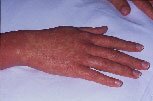|
May 2000
Case of the Month: A twelve year-old HIV-infected girl begins antiretroviral therapy. One week later she presents with a pruritic rash.
Answer: Non-nucleoside reverse transcriptase inhibitor (efavirenz) associated rash
 
Discussion: Efavirenz (Sustiva), the newest non-nucleoside reverse transcriptase inhibitor (NNRTI) has many advantages, including once a day dosing. In combination with NRTIs, efavirenz has been shown to significantly reduce viral load and increase CD4 count.
Rash is one of the most common side effects observed with efavirenz. In adult studies of efavirenz, 27% of the patients developed a rash, compared with 17% taking placebo. In pediatric trials, rash was noted in 40.3% of patients. The rash associated with efavirenz typically appears within the first two weeks of initiating therapy. The median time of onset is 11 days for adults and 8 days for children. It is generally a maculo-papular, pruritic rash covering the entire body. Treatment includes antihistamines and/or corticosteroids as needed. Medication should not be stopped unless the rash is associated with blistering, desquamation, mucosal involvement or fever. The rash will typically resolve within one month of starting therapy with efavirenz.
Other common side effects associated with efavirenz include dizziness, impaired concentration, somnolence, abnormal dreams and insomnia. These symptoms tend to improve as the drug is being taken and are tolerated better if the medication is dosed in the evenings. Rarely, efavirenz has been associated with delusions and inappropriate behavior.
|